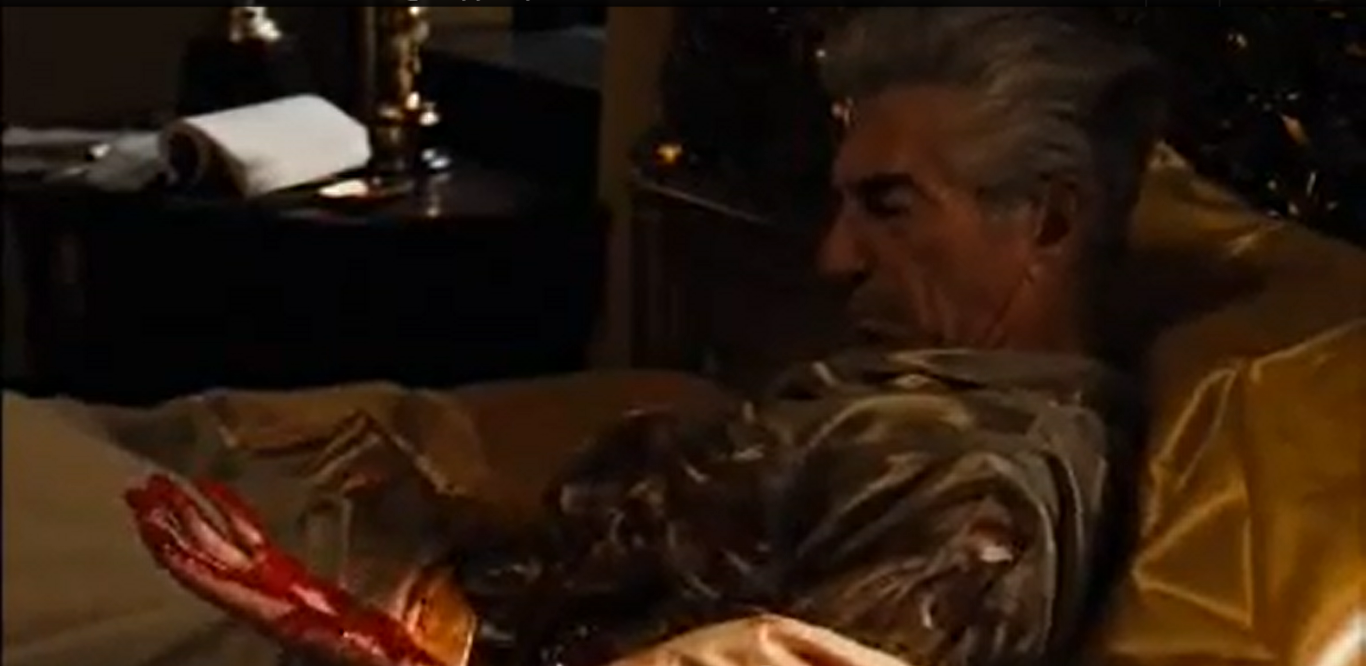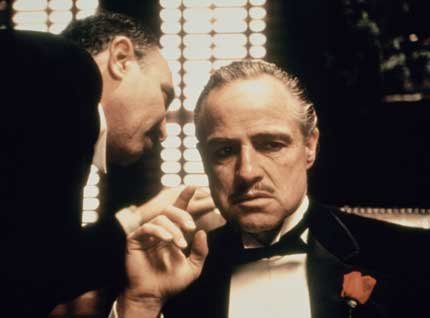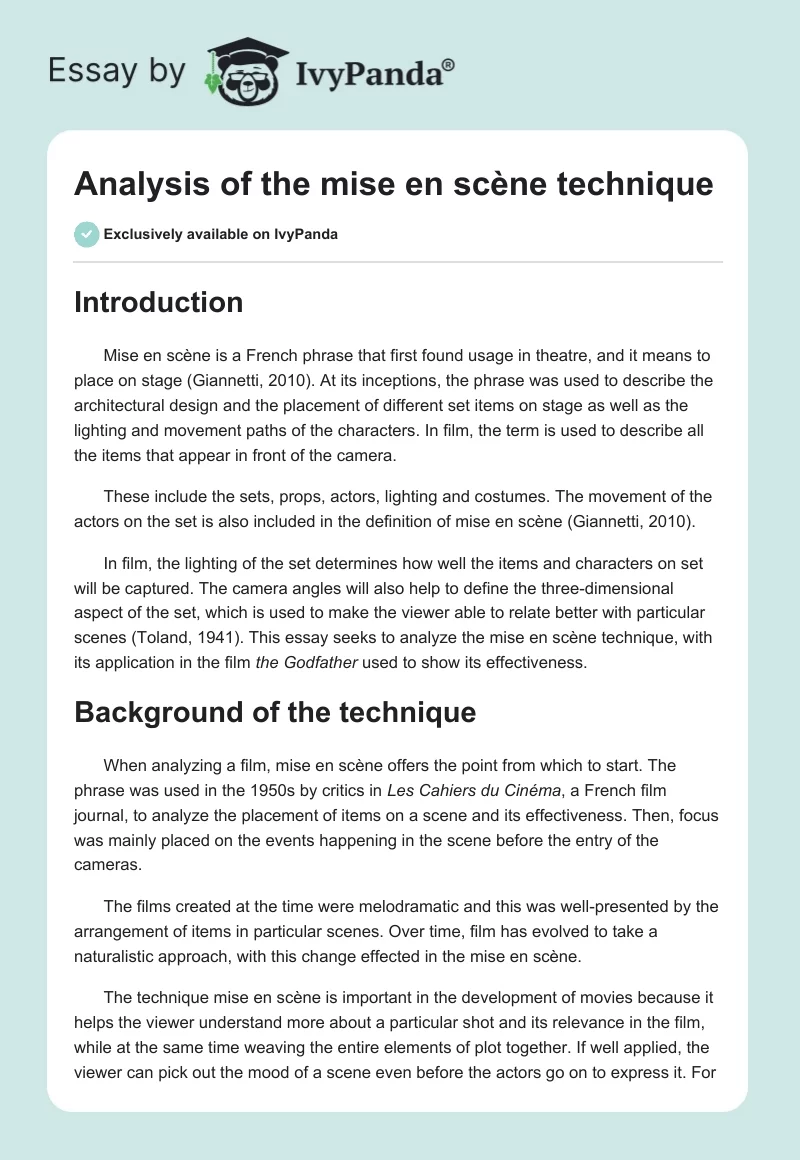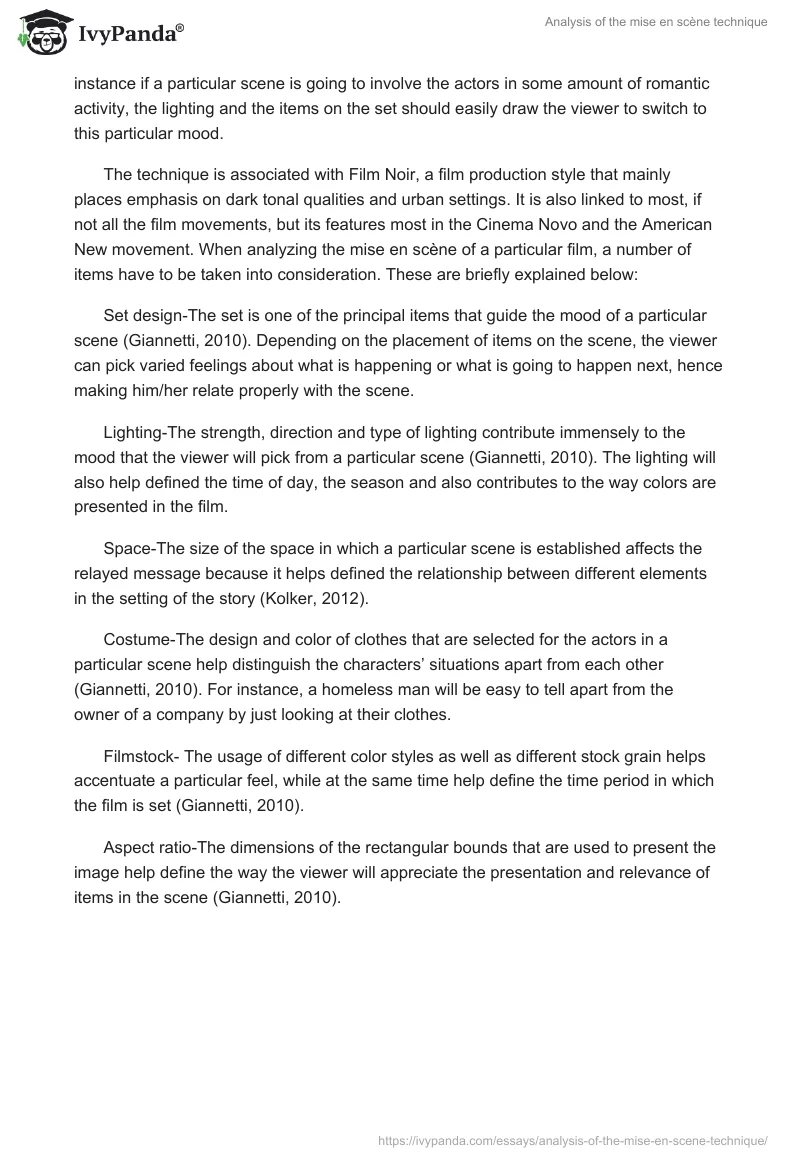Introduction
Mise en scène is a French phrase that first found usage in theatre, and it means to place on stage (Giannetti, 2010). At its inceptions, the phrase was used to describe the architectural design and the placement of different set items on stage as well as the lighting and movement paths of the characters. In film, the term is used to describe all the items that appear in front of the camera.
These include the sets, props, actors, lighting and costumes. The movement of the actors on the set is also included in the definition of mise en scène (Giannetti, 2010).
In film, the lighting of the set determines how well the items and characters on set will be captured. The camera angles will also help to define the three-dimensional aspect of the set, which is used to make the viewer able to relate better with particular scenes (Toland, 1941). This essay seeks to analyze the mise en scène technique, with its application in the film the Godfather used to show its effectiveness.
Background of the technique
When analyzing a film, mise en scène offers the point from which to start. The phrase was used in the 1950s by critics in Les Cahiers du Cinéma, a French film journal, to analyze the placement of items on a scene and its effectiveness. Then, focus was mainly placed on the events happening in the scene before the entry of the cameras.
The films created at the time were melodramatic and this was well-presented by the arrangement of items in particular scenes. Over time, film has evolved to take a naturalistic approach, with this change effected in the mise en scène.
The technique mise en scène is important in the development of movies because it helps the viewer understand more about a particular shot and its relevance in the film, while at the same time weaving the entire elements of plot together. If well applied, the viewer can pick out the mood of a scene even before the actors go on to express it. For instance if a particular scene is going to involve the actors in some amount of romantic activity, the lighting and the items on the set should easily draw the viewer to switch to this particular mood.
The technique is associated with Film Noir, a film production style that mainly places emphasis on dark tonal qualities and urban settings. It is also linked to most, if not all the film movements, but its features most in the Cinema Novo and the American New movement. When analyzing the mise en scène of a particular film, a number of items have to be taken into consideration. These are briefly explained below:
Set design-The set is one of the principal items that guide the mood of a particular scene (Giannetti, 2010). Depending on the placement of items on the scene, the viewer can pick varied feelings about what is happening or what is going to happen next, hence making him/her relate properly with the scene.
Lighting-The strength, direction and type of lighting contribute immensely to the mood that the viewer will pick from a particular scene (Giannetti, 2010). The lighting will also help defined the time of day, the season and also contributes to the way colors are presented in the film.
Space-The size of the space in which a particular scene is established affects the relayed message because it helps defined the relationship between different elements in the setting of the story (Kolker, 2012).
Costume-The design and color of clothes that are selected for the actors in a particular scene help distinguish the characters’ situations apart from each other (Giannetti, 2010). For instance, a homeless man will be easy to tell apart from the owner of a company by just looking at their clothes.
Filmstock- The usage of different color styles as well as different stock grain helps accentuate a particular feel, while at the same time help define the time period in which the film is set (Giannetti, 2010).
Aspect ratio-The dimensions of the rectangular bounds that are used to present the image help define the way the viewer will appreciate the presentation and relevance of items in the scene (Giannetti, 2010).
Mise in scène in the Godfather-The horsehead scene

It is late in the night. Mr. Woltz is sleeping when he wakes up to the feel of some wetness on his beddings. He is initially not concerned and only gets concerned when he flaps open the rest of the beddings only to realize that there is more blood. Eventually the scene unfolds to reveal that the blood is actually from the head of a dead horse, strategically placed to cause the scare. The composition of the scene, in the move The Godfather is very well thought-out and it helps produce the scary effect that the director Francis Coppola, had in mind.
The dorminant in the shot is the Mr. Woltz himself and he immediately garners the attention even amidst a number of items, some of which make the background. The artificial lighting shining on his body makes him stand out. After the image of Mr. Woltz, the camera shifts to drive the attention of the viewer to the blood in the beddings and on his hand, which provides the main subsidiary contrast. The eye searches this out because of the intrinsic interest it holds in the development of the plot.
After the beddings, the eye shifts to the items in the background, which include a bedside stool that has a number of items lying on top of it. Because of the lighting design and placement of the centre of attraction, it is difficult to clearly define these items because they are almost out of focus. These items appear in the shot to offer some 3-D effect and a balance.
The angle of the shot and the structure of the composition indicate a high level of stability. The density of the shot is average and the viewer can easily make out the two main elements: Mr. Woltz and the blood. With these two items taking prominence in the scene an appreciable amount of tension is created, which is enough to keep the viewer waiting for the next development.
Because of the tension that is created by the structure of the shot, the viewer is easily drawn into the unfolding without the conscious thought of the director’s intrusion. The lines of the shot are almost fully horizontal, with everything except the beside-lamp (in the background) assuming a horizontal orientation.
The character placement in the shot complements the shots stability. The shot is short and tightly framed with the main character occupying more than half of it. The placement of the character running across the bottom half of the shot makes the shot bottom heavy, which essentially makes it very stable.
The form of the shot is closed because the camera focus was fixed on a particular individual. Compared with the other elements in the shot, Mr. Woltz takes all the prominence in the scene making all other elements appear inconsequential. In addition, the staging position of the main character gives prominence to his individual personality, because we can see his face, which guides the viewer to draw conclusions about his character.
The eeriness of the moment is well presented by use of artificial lighting, which helps heighten the tension in the shot to almost surreal levels. The lens used is of the hard focus type and it helps the viewer identify with the main purpose of the scene from early on. The focus is deep and follows the natural way that the eye would have perceived things had the viewer been on the set.

In the party scene (above), Vito Corleone is seated on one corner and an unknown person comes to whisper something to his ear, alerting him of some upcoming danger. In a shot from the scene, Vito appears to be keenly listening to the message being conveyed to him. In the shot, the Vito is dorminant and he takes up almost three quarters of it. The shot itself is very stable given that the characters in the scene are balance out the bottom and middle parts.
Artificial lighting was used in the shot to create the intense mood that the director wanted to bring out. The shot is also tightly framed, with the two characters having very little room to move in. Looking at the shot from the positions of the actors, Vito was taken from a full-frontal position, while the unnamed character is taken from a three-quarter turn, confirming his anonymity.
Conclusion
In summary, the shots under study have been of contrasts, with the elements contained in it bearing stark contrast. The strength of Mr. Woltz and the blood in the shot is contrasted with the dullness of the background items. The Thematic association of the elements in the shot is also in contrast. Mr. Woltz appears almost composed on face value but the way he handles the blood on his beddings seems to have given him some slight scare.
In the second shot, Vito Corleone commands a presence by occupying almost three quarters of the screen space. The other character has been subordinated by the amount of attention and screen space allotted. The lighting in shot has also been used effectively to create the desired mood. As defined by this scene, the entire film underscores the strengths of the Godfather in a complex and ambivalent way.
This essay had set out to give a study of the film technique mise en scène. For this purpose, a background check was provided, with some of its key constituents evaluated. The discussion then shifted to the film the Godfather, where the presentation of the technique was highlighted. It should be noted that even though the analysis was based on one shot, the same breakdown can apply in many other shots, like the ones attached below.
Reference List
Giannetti L. (2010). Understanding movies (12th ed.). Massachusetts, USA: Allyn & Bacon
Kolker, R. (2012). “Mise en scene”. Film Form and Culture. pp. 1-33.
Toland, G. (1941). How I broke the rules in Citizen Kane. Popular Photography, 8 (55), 90-91.


